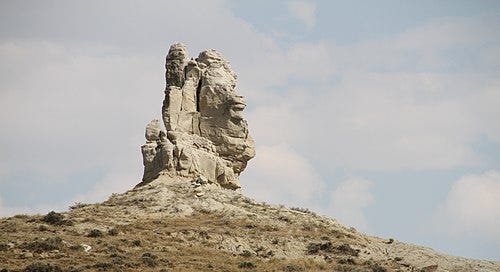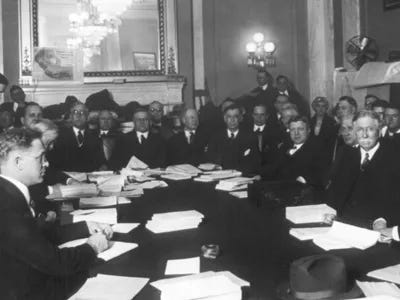Issue #105 American History August 11, 2022 (about 4 minutes reading time)
Over the centuries, there have been many presidential scandals. Every single one of the 46 presidents has had a scandal of one kind or size or another in their executive branch. Republican Ronald Reagan’s presidency was marked by numerous scandals, resulting in the investigation, indictment, or conviction of over 138 administration officials, the largest number for any president in American history.
In the 20th and 21st centuries:
1921-1922: The Teapot Dome Scandal
1973-1974: The Watergate Scandal
1985-1987: The Iran-Contra Affair
1998-1999: The Bill Clinton-Monica Lewinsky Affair
2020 - still going on: The Trump Election Denier Scandals
The major players in most of these scandals were other people in an administration, and all of those listed above, except for Bill Clinton, who was impeached for lying about a sex act, occurred during Republican administrations.
What was the Teapot Dome Scandal?
Before Watergate, the Teapot Dome scandal was considered the worst in American history. This scandal empowered the United States Senate to conduct numerous investigations into corruption in the government and was the first time that a presidential cabinet member was jailed for committing a felony while in office.
In the early 1900s, the U.S. Navy was in the process of converting its coal-fueled ships to oil-fueled ships. The Navy officials wanted to ensure that there would be enough oil available in case another war broke out or there was some other national emergency.
During the administration of Republican President William Howard Taft (1909 - 1913), Congress began to set aside federal lands that contained oil as emergency reserves: Teapot Dome in Wyoming, and Elk Hills and Buena Vista Hills in California.
Republican President Warren G. Harding (1921-1923) won the presidency with the backing of oil tycoons (most of them from Ohio) who were promised oil-friendly cabinet positions in return.
The Oil Barons hit a “gusher”
Harding, who promised a “return to normalcy” after World War I, campaigned on a platform of balancing the interests of conservation heralded by Republican President Theodore Roosevelt and letting industry and business interests have more control over the wealth of the nation.
Harding appointed New Mexico Senator Albert Fall as his Secretary of the Interior in 1921. Almost immediately, Fall convinced Harding to transfer oversight of the oil reserves from the Navy to his Department of the Interior.
The next year, 1922, there was no competitive bidding or even a public announcement as Fall leased exclusive drilling rights to the entire Teapot Dome site to the Mammoth Oil Company, which just happened to be owned by his friend Harry Sinclair.
Fall also leased the drilling rights of the two oil reserves in California to another friend, Edward Doheny, who owned the Pan-American Petroleum Company.
It was estimated that the three sites contained hundreds of millions of dollars of high-grade oil. The original intent of the oil reserves, to ensure that the U.S. Navy had enough oil for their ships, was all but forgotten.
The Senate started the first of many far-reaching investigations while Fall and his family netted over $300,000 (about $4.5 million in today’s dollars) in Liberty bonds and in “loans” that did not have to be repaid.
The Wall Street Journal was the first newspaper to alert the public about those shady deals in an article published on April 14, 1922.
Later, when the Denver Post began to publish editorials about everything going on at and around Teapot Dome, publishers managed to blackmail Henry Sinclair to pay $1 million to them and $1 million to another oilman who felt the Teapot Dome lease cheated him.
Repercussions of the Scandal
There were several negative outcomes because of the Teapot Dome scandal, although many of the people involved were cleared of wrongdoing.
The U.S. Congress directed Harding to cancel the leases and the Supreme Court declared the leases fraudulent and Harding’s transfer of authority illegal, and the lands were returned to Navy control.
President Harding was so distressed and disillusioned at his friends’ and appointees’ misconduct, that he fell ill and died of a heart attack in August 1923 before the end of his term.
During a Senate investigation, Fall tried to claim that he kept the lease agreements secret to “protect the locations of valuable national resources,” but in 1929, Fall was convicted of accepting a bribe from his friend Doheny, fined $100,000 (about $1.5. million in today’s dollars), and sentenced to one year in prison.
Although Doheny was cleared of offering the bribe, his son Ned was murdered in their new Beverly Hills home by a friend who feared he would also be implicated in the scandal. The friend, Hugh Plunkett, then killed himself.
Sinclair, who had received the first of the illegal drilling rights, refused to answer some of the questions posed to him during the Senate hearings, claiming that Congress did not have the right to pry into his private affairs. His refusal was challenged and eventually reached the Supreme Court in 1929.
The Supreme Court ruled that Congress did indeed have the right to fully investigate cases where the laws of the country were violated, and Sinclair served six months in prison for contempt of Congress and jury tampering.
Fall eventually lost all of the wealth he gained during the scandal, and Doheny foreclosed on his New Mexico ranch.
If some of these events and outcomes from the past remind you of what is happening around the twice-impeached 45th president these days, you are right! “Those that fail to learn from history are doomed to repeat it.” ~~Sir Winston Churchill
Did you learn anything new about the Teapot Dome Scandal? If so, please let us know in the comments.
We’re at 93 subscribers! Who do you know who would enjoy “We Are Speaking?”
Read and listen to “We Are Speaking” on the iOS app!
Support us with your own free or paid subscription:







I had never heard of the Teapot Dome scandal. Extremely interesting and relevant to today's politics.